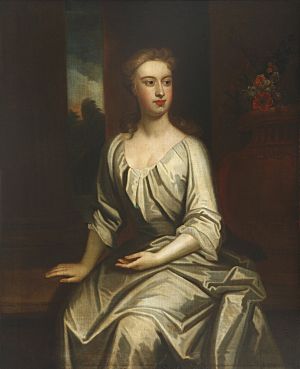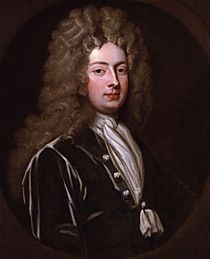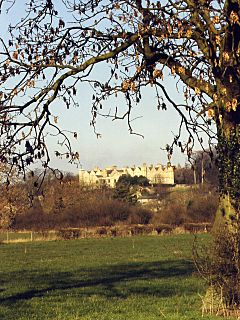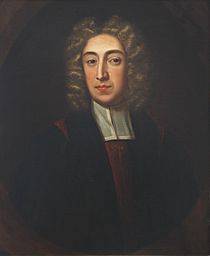Lady Elizabeth Hastings facts for kids
Quick facts for kids
Lady Elizabeth Hastings
|
|
|---|---|

Lady Elizabeth Hastings by Godfrey Kneller
|
|
| Born | 19 April 1682 Charles Street, London |
| Died | 21 December 1739 Ledston Hall, Yorkshire |
| Father | Theophilus Hastings, 7th Earl of Huntingdon |
| Mother | Elizabeth Lewis (died 1688) |
Lady Elizabeth Hastings (born April 19, 1682 – died December 21, 1739) was an amazing English woman. People also called her Lady Betty. She was known for helping others, being very religious, and supporting education for girls and women. Elizabeth was smart and full of energy. She knew many artists, writers, and designers. She was also a clever investor and liked new ways of farming.
Elizabeth chose not to marry, even though she had many offers. When she passed away in 1739, her nephew Francis inherited her home. The rest of her money was used to create special funds for education. These funds still help students today with scholarships at The Queen's College, Oxford. They also support the 'Lady Elizabeth Hastings Charities'. Several primary schools in West Yorkshire are named after her.
Her Early Life and Family
Elizabeth was born in April 1682 in London. Her father was Theophilus Hastings, 7th Earl of Huntingdon. Her mother was Elizabeth Lewis, who was very wealthy. Her mother owned Ledston Hall in West Yorkshire.
Elizabeth was one of nine children. But only she and her brother George (who later became the 8th Earl of Huntingdon) lived to be adults. Her mother died in 1688. Two years later, her father married Mary Fowler. They had six more children together.
Elizabeth's father and brother George had a disagreement about the Ledston estate. This led to a legal fight. It was finally settled in 1703, after her father died. Elizabeth then received Ledston Hall and a lot of money each year. When George suddenly died in 1705, she inherited even more.
Elizabeth was young, attractive, and very rich. People said she was witty and kind. She received many marriage proposals. But her letters show that she chose to stay single.
George's titles went to his half-brother Theophilus. Elizabeth paid for a special memorial for George. It is still in St James' Church, Piccadilly. George also had a son named Henry. Elizabeth raised Henry. He is thought to be the Henry Hastings who helped manage money for a Christian knowledge society later on.
Elizabeth also helped educate her younger brothers and sisters. Her four half-sisters lived at Ledston Park for many years. In 1726, she helped arrange Theophilus's marriage to Selina Hastings. Selina became a very important person in the early Methodist movement. She even started her own religious group.
Lady Elizabeth's Work and Beliefs
Elizabeth's father was a close supporter of King James II. King James II lost many supporters because people thought he was pushing Catholicism too much. Elizabeth's father was one of the few who supported him until the end. This hurt his reputation. Elizabeth remembered her mother's death in London in 1688. There was a lot of panic and rioting outside because people feared a Catholic invasion.
In those times, women like Elizabeth often found ways to help through religion and education. These were seen as good roles for women. Elizabeth followed her father's strong Church of England beliefs. She was not a supporter of the exiled King James II. Many of her religious friends were "Nonjurors." These were people who refused to promise loyalty to King William III after the 1688 Glorious Revolution. Most of them simply felt they had to keep their promise to James. This issue mostly went away when James died in 1701.
One of her friends was Joseph Smith. He became a leader at The Queen's College, Oxford. He later convinced Elizabeth to give money for scholarships at the college. Smith was part of a group that believed in strong Church of England values. He was also known for helping Catholic nobles become Anglicans. In 1715, he advised Elizabeth to take an oath. This oath said she did not support James Francis Edward Stuart as king. Smith also guided her when she became interested in Methodism. This was a reform movement within the Church of England.

Elizabeth was also connected to the Society for the Propagation of Christian Knowledge. This group helped spread Christian teachings. Through this, she met Robert Nelson, a wealthy helper of others. His writings were even read at Ledston. In 1709, Elizabeth and Lady Catherine Jones helped fund a girls' school in Chelsea. This school was supported by the Society. It is believed to be the first school in England run by an all-women board.
The school's lessons were managed by Mary Astell. She was an educationalist sometimes called the first English feminist. Astell shared Elizabeth's beliefs. She is famous for asking, "If all Men are born free, how is it that all Women are born Slaves?" Elizabeth was also related to the famous poet and playwright William Congreve. He mentioned her in a journal called Tatler. Another writer, Richard Steele, wrote that knowing her would "check loose behaviour" and loving her was "a liberal education."

Elizabeth was known for her kind nature. She was a generous host, even though she lived simply herself. The gardens at Ledston were designed by Charles Bridgeman. He also designed gardens at St James's and Hyde Parks. Elizabeth was seen as a forward-thinking landlord. She encouraged her tenants to use new farming methods like irrigation and fertilizers.
She had one of the first personal bank accounts with Hoare's Bank. She used it for her business dealings. This included investing in the early stock market. This helped her have cash, as land wealth was not always easy to use quickly. This gave her more freedom to make donations. Several primary schools in West Yorkshire still carry her name. These include schools in Ledston, Collingham, and Thorp Arch. In 1721, she gave a large donation to help build Holy Trinity Church, Leeds. She also helped with ideas for its design.
Elizabeth became ill in 1738. She passed away at the end of 1739. She was buried in All Saints Ledsham, a very old church. Her tomb was designed by Peter Scheemakers.
Her Lasting Legacy
Elizabeth left Ledston and its library to her nephew Francis. This was a bit of a surprise to Lady Selina, who needed more money for her own charity work.
Elizabeth's money from her Wheldale estate helped fund scholarships at Queen's College for students from northern England. This area later had the Wheldale Colliery coal mine. The rest of her money created the 'Lady Elizabeth Hastings Charities'. These charities focus on education, mostly in the North of England. They still exist today. Since 2008, they have given out over £2.2 million in grants.



